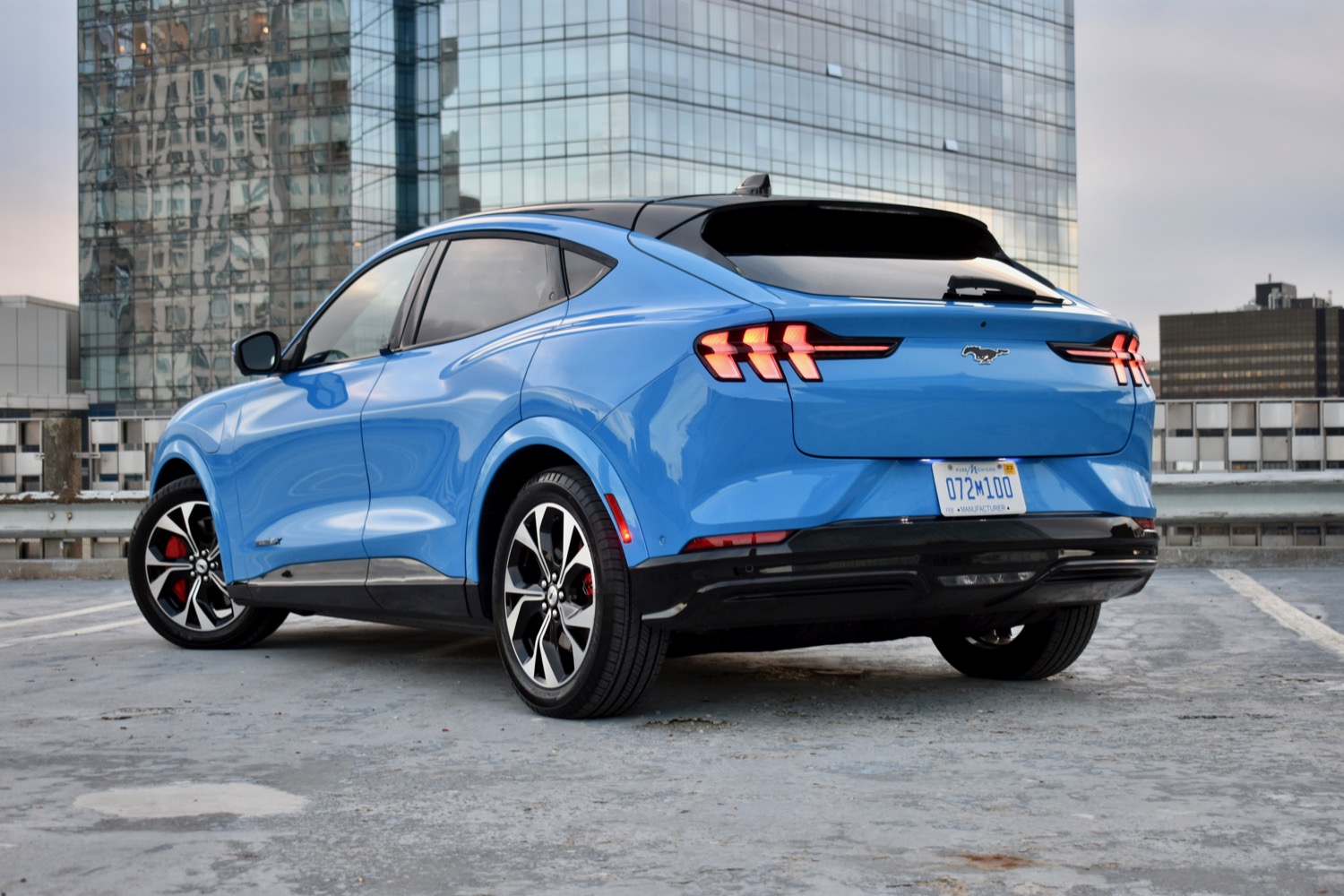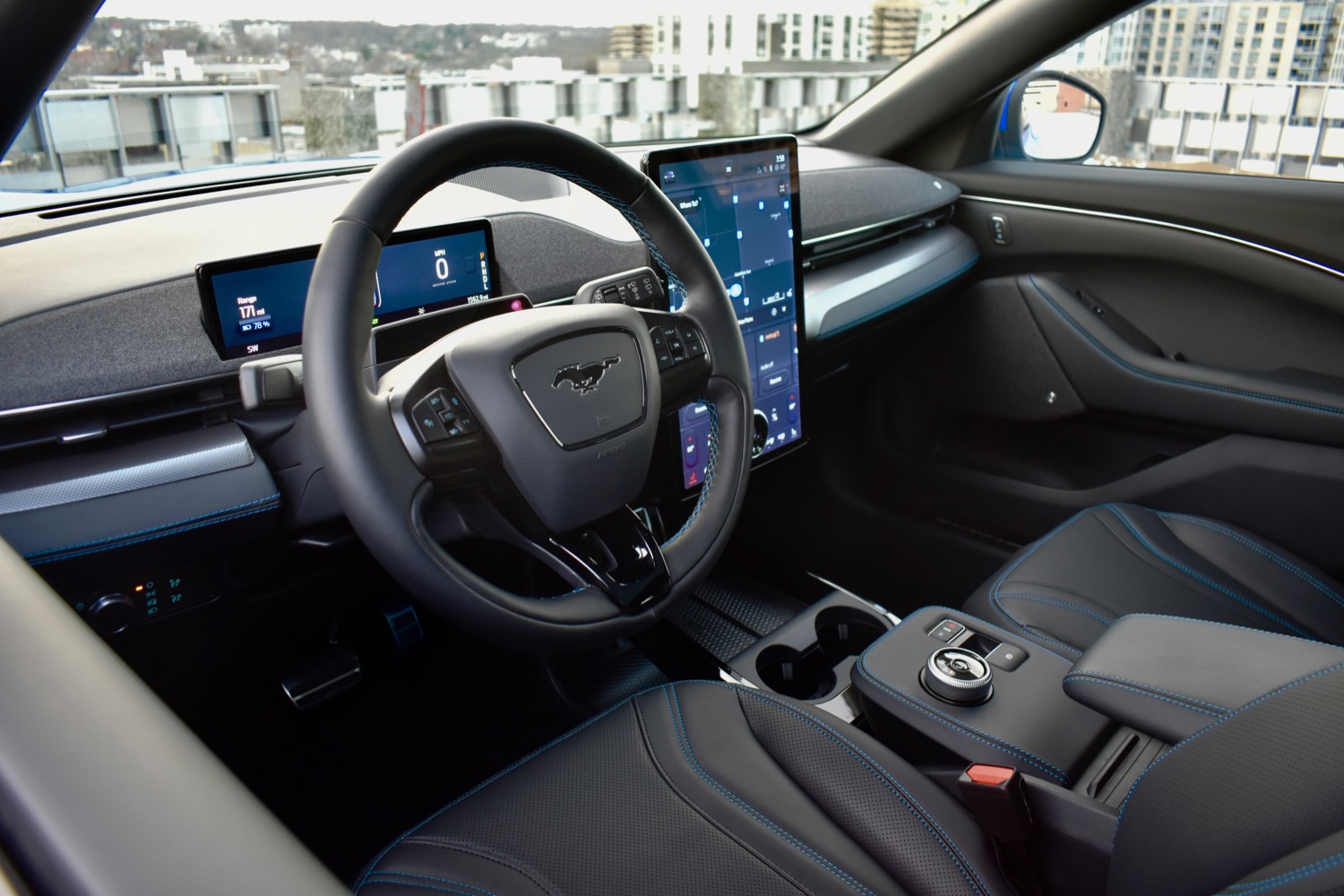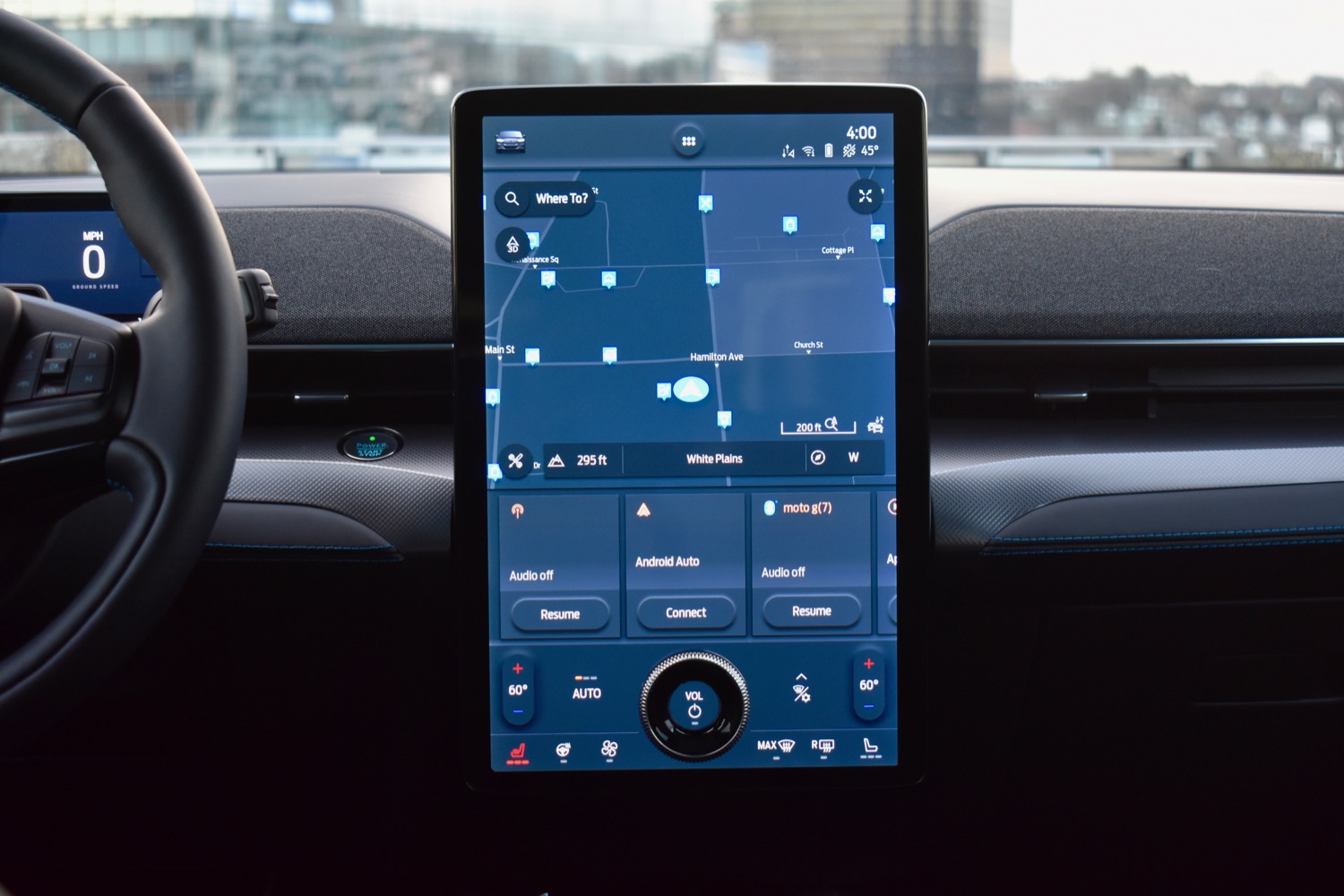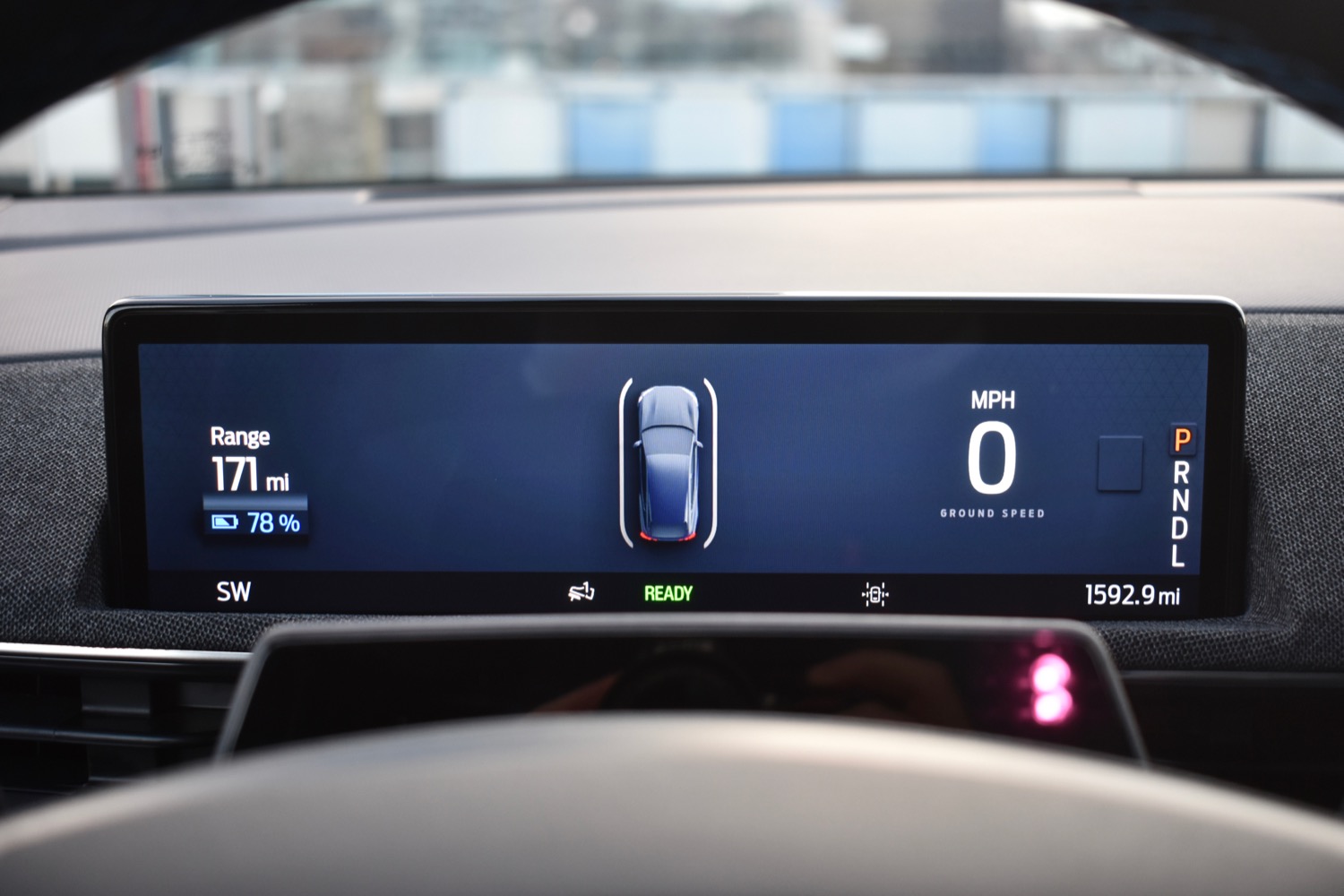For its first serious attempt at a mass-market electric car, Ford decided to launch a crossover SUV inspired by one of its most iconic models, the Mustang.
The 2021 Ford Mustang Mach-E will likely prove controversial with traditional fans, who are used to Mustangs having only two doors, with V8 engines under the hood. While the original Mustang is a stereotypical muscle car with decades of history, the Mach-E takes its place in a growing field of electric crossovers, competing with the Tesla Model Y and the upcoming Volkswagen ID.4 and Nissan Ariya.
Ford offers the Mach-E in four trim levels — Select, California Route 1, Premium, and GT — plus a sold-out First Edition model to mark the start of production. Buyers can also choose between Standard Range and Extended Range battery packs, and rear-wheel drive or all-wheel drive.
The base rear-wheel-drive Select starts at $43,995, while our First Edition test car rang up at $59,400. The First Edition is mechanically identical to the Extended Range, all-wheel-drive Premium model, but with some cosmetic differences, such as red brake calipers and brushed-aluminum pedals.
Design and interior
The Mach-E is the first production four-door model to wear the hallowed Mustang name, but that doesn’t mean Ford stretched out the existing Mustang platform to make it. The Mach-E is the first mass-produced Ford electric car not based on an existing model, allowing engineers to design the entire car around the powertrain.
Ford still wanted this crossover to look like a Mustang, though, so it gets a long hood and bulging fenders, with a low, streamlined, roof. From both outside and from behind the wheel, the Mach-E feels more like a regular car than an SUV. It sits fairly low to the ground, and the driving position doesn’t provide the commanding view of the road many SUV shoppers want. However, you could say the same thing about the Tesla Model Y and VW ID.4, which don’t exactly look like rugged SUVs either. Plus, “Mustang-inspired station wagon” probably wouldn’t sound as good in ad copy.
From both outside and from behind the wheel, the Mach-E feels more like a regular car than an SUV.
If the exterior design was inspired by the original Mustang, the interior design was inspired by Tesla. Ford took the same minimalist approach, using a massive dashboard screen to replace most analog controls. It’s not a very elegant solution, but then again neither is the Tesla design Ford seems to have blatantly copied. Interior materials seemed to be of decent quality, but it’s possible that people spending nearly $60,000 on a new car might be disappointed by the lack of leather seats.
Thanks to the sleek exterior styling, the Mach-E interior doesn’t feel especially spacious. The Model Y offers slightly more headroom and front legroom, with a significant 2.4 inches more rear legroom. The Tesla’s 68.0 cubic feet of cargo space (with the second row folded) also beats, the Ford’s 59.7 cubic feet, and Tesla offers a third-row seat option as well. Tesla doesn’t publish a figure for cargo space with the second row in place, but the Mach-E offers 29.7 cubic feet, which is more than you get in the more traditionally styled Audi E-Tron. The Mach-E also sports a 4.7-cubic-foot frunk.
Tech, infotainment, and driver assist
Ford came out swinging on tech. The Mach-E gets a 15.5-inch touchscreen and 10.2-inch digital instrument cluster, running the latest Sync 4 infotainment system. Wireless Apple CarPlay and Android Auto are standard along with SiriusXM with 360L satellite radio, wireless phone charging, and USB ports for the first and second rows.
Sync 4 is a new system, with a redesigned interface, but the user experience doesn’t feel dramatically different from the old Sync 3 system. Ford still relies on text-heavy tiles for most functions, but the Mach-E’s 15.5-inch screen creates more room for them, allowing them to show more information. The bottom row of the screen is dedicated to temperature controls and a large volume knob, which is fitting, as analog controls would normally be located in this area. The icon for the driver’s seat heater was in exactly the same spot as the seat-heater button on the Bronco Sport we tested just before the Mach-E.
In practice, this setup shows that the utility of giant screens has its limits. It was much easier to press a button to turn on the Bronco Sport’s seat heater than using the Mach-E’s screen, as that was a two-step process that involved pressing the icon and manipulating a slider with no tactile feedback.
It also seems Ford didn’t know what to do with so much screen space. Aside from a cool startup sequence, the graphic design is plain (it looks like it was inspired by Ford’s own website) and relies too much on text. While the size of the screen allows the text to be bigger, and thus easier to read while driving, there’s so much of it that it’s hard to know where to look at a glance.
Ford didn’t seem to know what to do with so much screen space.
Like most other Ford models, the Mach-E gets a decent array of standard driver-assist tech under the Co-Pilot360 banner. All trim levels get automatic high beams, blind-spot monitoring, lane-keep assist, automatic emergency braking, post-collision braking, a reverse sensing system, reverse automatic braking, adaptive cruise control with automated lane centering, traffic-sign recognition, and evasive steering assist, which adds more power assist during emergency maneuvers.
The Mach-E will also be one of the first Ford models to get the automaker’s new Active Drive Assist. This is Ford’s answer to Tesla Autopilot, allowing the car to handle acceleration, braking, and steering on designated sections of divided highways. Drivers will be able to take their hands off the wheel when the system is active, but a driver-facing camera will monitor for distraction, according to Ford.
However, Active Drive Assist won’t be available at launch. Cars will ship with the required hardware, while the software will be added in third-quarter 2021 via an over-the-air update. Active Drive Assist is standard on the California Route 1, Premium, and First Edition trim levels, and part of a $3,200 package on the Select model, which includes other features. Regardless of trim level, customers will have to pay $600 for the software, when it becomes available.
Driving experience
The Mach-E is a true Mustang in that it offers a bewildering array of powertrain options. That ranges from the base rear-wheel drive Select, which makes 266 horsepower and 317 pound-feet of torque, to the all-wheel-drive GT Performance Edition, which boasts 480 hp and 634 lb.-ft. Ford says the Performance Edition will do zero to 60 mph in 3.5 seconds, matching the Tesla Model Y Performance. However, Ford hasn’t said whether the Mach-E will beat the Tesla’s 155 mph top speed.
No matter which version you get, though, you’ll end up with a fairly quick car. Even the base Select model will do zero to 60 mph in 6.1 seconds, per Ford. To put that in perspective, a Chevrolet Bolt EV takes 6.5 seconds to reach 60 mph from a standstill.
Our First Edition test car shares its powertrain with the Premium trim level, meaning you get 346 hp and 428 lb.-ft. of torque, with all-wheel drive. That’s good for zero to 60 mph in 4.8 seconds, according to Ford, which is quicker than the much pricier Audi E-Tron, and only 0.3 slower than the premium-priced Jaguar I-Pace.
The Mach-E stands out among non-Tesla electric cars by offering a genuinely sporty driving experience.
It’s not just straight-line acceleration, either. The Mach-E stands out among non-Tesla electric cars by offering a genuinely sporty driving experience. The car felt nicely planted in corners which, along with responsive steering, helped build confidence. Like most electric cars, the Mach-E is pretty heavy for its size, but it camouflaged that weight well. Instead of pummeling the laws of physics into submission, the Mach-E flowed smoothly through corners like a much lighter vehicle.
The flip side of that sporty handling was a harsh ride on anything but the smoothest pavement. That’s a typical trade-off in performance vehicles, though. We also didn’t see a dramatic difference between the three drive modes — Engage, Whisper, and Unbridled — but that shouldn’t overshadow what is otherwise a well-composed chassis.
Range, charging, and safety
With the 68-kilowatt-hour Standard Range battery pack and rear-wheel drive, the Mach-E has an EPA-estimated range of 230 miles; that drops to 211 miles with all-wheel drive. The 88-kWh Extended Range pack allows for 300 miles of range with rear-wheel drive and 270 miles with all-wheel drive. That means no version of the Mach-E can match the all-wheel-drive Tesla Model Y Long Range’s 326-mile range, while entry-level versions fall short of the less-expensive VW ID.4 Pro and Chevy Bolt EV, which offer 250 miles and 259 miles of range, respectively.
The Mach-E gets standard DC fast charging, using the Combined Charging Standard (CCS). It can charge at up to 150 kilowatts, allowing the Standard Range battery pack to go from a 10% charge to an 80% charge in 38 minutes, according to Ford. During our test drive, it took 36 minutes to go from 22% to 80% on a cold day.
For home charging, Ford includes a cable that allows the Mach-E to plug directly into the outlets used by large appliances, such as ovens, allowing it to charge at the same 240 volts as a purpose-built AC home charging station. Alternatively, Ford is coordinating with Amazon Home Services to have those charging stations installed at customers’ homes.
Safety ratings from the Insurance Institute for Highway Safety (IIHS) and National Highway Traffic Safety Administration (NHTSA) aren’t available yet. That’s often the case with new vehicles.
The Mach-E gets the same three-year, 36,000-mile, bumper-to-bumper warranty and five-year, 60,000-mile powertrain warranty as other Ford models, along with an eight-year, 100,000-mile, battery warranty. It’s difficult to predict the future reliability of new models like the Mach-E, but electric cars require less regular maintenance than gasoline cars.
How DT would configure this car
The Premium trim level, with the Extended Range battery pack and all-wheel drive, seems to be the sweet spot of the lineup. It gets features like a 360-degree camera system as standard equipment, as well as the hardware for Active Drive Assist, should you want it. The GT Performance Edition offers more power and quicker acceleration, but we don’t feel it’s a big enough difference to justify that model’s higher price. While it does cut down on range, we feel the all-wheel drive is worth getting for its foul-weather benefits. Isn’t that one of the main reasons for getting an SUV, after all?
Our take
New electric cars from established automakers are habitually discussed as “Tesla rivals,” but it’s clear that Ford paid close attention to the Silicon Valley firm when developing the Mach-E. It’s just too bad Ford picked up some lessons — like installing an oversized infotainment touchscreen, or asking customers to pay upfront for driver-assist tech that will be added later — but not others, like the focus on efficiency that allows the Model Y to beat the Mach-E on range.
Ford also wanted the Mach-E to be a Mustang and, while it feels different from any version of the iconic “pony car” we’ve driven, the DNA is still recognizable. In its most potent form, the Mach-E matches the Model Y in acceleration, and it’s a lot of fun when the road gets twisty as well. The Mach-E probably won’t win over the most conservative Mustang fans, but it shows the nameplate has a future in the age of electrification.
While the original Mustang is pitched as a performance value, the Mach-E is priced out of the EV mainstream. If all you want is zero-emission transportation, the VW ID.4 is a better value at its $39,995 base price. The VW doesn’t have the style and performance of the Ford, though.
Where the Mach-E does make sense is as an alternative to the Jaguar I-Pace and Audi E-Tron. Those luxury electric SUVs start at around $70,000, but at $59,400 as-tested, our Mach-E was quicker than the Audi, and boasted more range than both. So for buyers willing to pay extra for a little more excitement, the Mach-E is a worthwhile option.
Should you get one?
Yes. The Mach-E has carved out its own little niche in the growing EV field.







